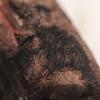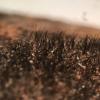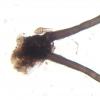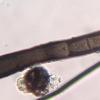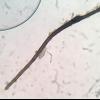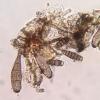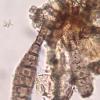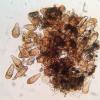
31-12-2025 19:27
Collected from loamy soil, at waterside (completel

30-12-2025 16:44
Pascal DucosBonjour,Une anamorphe rose stipitée, très nombre

30-12-2025 17:14
 Bernard CLESSE
Bernard CLESSE
Bonjour à toutes et tous,Pourriez-vous aider Albe

29-12-2025 10:15
Hulda Caroline HolteHello, I found and collected this propoloid ascom

30-12-2025 09:04
Hello.A Pyrenomycete sprouting sparsely but very d

29-12-2025 17:44
Isabelle CharissouBonjour,J'aimerais savoir si d'autres personnes au

12-11-2021 00:03
Lepista ZacariasHi everybody,A week ago in my fiels trip I noticed
Associated with this mount I found two types of conidiospores, so I am uncertain which, if either, belongs to this organism...The first type: Shaped like a bowling pin (ellipsoid, but tapering to a narrow knob at one end), light brown, 4-8(+)septate, others simply ellipsoid, septate, about 32-72 by 10-15µm.
The second type of conidiospores I saw: Light brown, paddle shaped conidiospores with a thick wall but especially thick at the wide end, 35-55 by 17-22µm.
Any ideas? Thank you in advance!
Cheers!
Jason, again thank you!
Dear Ethan,
the hairy structures you illustrate match well conidiophores of Helminthosporium velutinum, which can form large effuse patches. In well preserved fresh specimens the acropleurogenous conidia sitting on the conidiophores are very distinct already under the hand lens, but your material may be rather old, so the conidia have already fallen off, or they didn't yet produce conidia (diffficult to decide without detailed microscopic investigations). In one of your pictures, these typical Helminthosporium conidia are well seen. As remains of spore production, in the conidiophores you should observe marginal pores in the upper cells, and also one at the top. However, sometimes many conidiophores remain sterile if the conditions for conidiation are unfavourable. Conidiophores can also stop growth and grow out again, this is also seen in some of your pictures.
See our publication on Helminthosporium in Studies in Mycology (freely downloadable at https://www.sciencedirect.com/science/article/pii/S0166061617300210)
There are also other Helminthosporium species around, for which you need more detailed investigations and measurements of conidiophores and conidia, but the most common species in temperate areas seems to be Helminthosporium velutinum. This species is also polyphagous and known from many different mainly woody but sometimes also herbaceous hosts.
The other type of conidia may represent undeveloped Helminthosporium conidia, this sometimes happens when there are unfavourable conditions during conidiogenesis and the conida die off before they reach full maturity. The conidia illustrated are obviously already dead. As the septa of the conidia of Helminthosporium are distosepta, they fully degrade some time after death, and only the outer wall is left over, which leaves the impression that the conidia are aseptate.
Cheers,
Hermann
Hi Jason,
what you identify as conidia are in fact conidiophores which terminated growth and resumed growth again at the apex. The same can happen when the tip is damaged, eaten by an insect etc, then the conidiophore resumes growth, leading to this phenomenon. Can be sometimes observed in Helminthosporium. The tip of the lower condidiophore is actively growing, but due to high contrast the outline of the hyaline wall there not fully visible.



